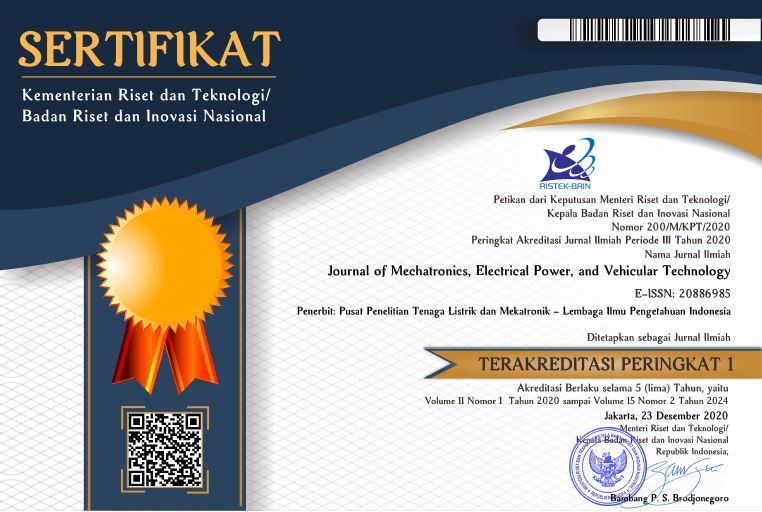Design of image classification system for fabric inspection process using Raspberry Pi
Abstract
Keywords
Full Text:
PDFReferences
S. Tereza, “Balancing global success with local production challenges in the garment manufacturing sector, Textile Industry Triumph:,” Amberd Buletin, pp. 38–47, 2023.
I. A. Juliannisa, P. Widodo, T. W. Nunuk, “Success Deteriminan of the Manufacturing Industry Sector to Survive During the Pandemic in Indonesia,” J. Econ. Financ. Manag. Stud., vol. 05, no. 08, pp. 2455–2467, 2022.
L. Petrie, “Sustainability and Circularity in the Textile Value Chain - A Global Roadmap Textile Value Chain,” U. N. Environment Programme, 2023.
P. N. Aurelia, A. Firdiansjah, and H. Respati, “The Application of Service Quality and Brand Image to Maintain Customer Loyalty by Utilizing Satisfaction Strategy in Insurance Companies,” Int. J. Adv. Sci. Res. Eng., vol. 5, no. 4, pp. 223–239, 2019.
İ. İlhan, “Concept of Industry 4.0 in Textile Manufacturing Processes,” Pamukkale Univ. J. Eng. Sci., vol. 25, no. 7, pp. 810–823, 2019.
J. Butt, “A strategic roadmap for the manufacturing industry to implement industry 4.0,” Designs, vol. 4, no. 2, pp. 1–31, 2020.
D. P. Mishra, S. Mishra, S. Jena, and S. R. Salkuti, “Image classification using machine learning,” Indones. J. Electr. Eng. Comput. Sci., vol. 31, no. 3, pp. 1551–1558, 2023.
S. Sha et al., “Image Classification and Restoration of Ancient Textiles Based on Convolutional Neural Network,” Int. J. Comput. Intell. Syst., vol. 17, no. 1, 2024.
M. Seçkin, A. Ç. Seçkin, P. Demircioglu, and I. Bogrekci, “FabricNET: A Microscopic Image Dataset of Woven Fabrics for Predicting Texture and Weaving Parameters through Machine Learning,” Sustainability, vol. 15, no. 21, p. 15197, 2023.
B. G. Batchelor, “Machine Vision for Industrial Applications BT - Machine Vision Handbook,” B. G. Batchelor, Ed., London: Springer London, 2012, pp. 1–59.
J. Xu, Y. Wei, A. Wang, H. Zhao, and D. Lefloch, “Analysis of Clothing Image Classification Models: A Comparison Study between Traditional Machine Learning and Deep Learning Models,” Fibres Text. East. Eur., vol. 30, no. 5, pp. 66–78, 2022.
K. Wisnudhanti and F. Candra, “Image Classification of Pandawa Figures Using Convolutional Neural Network on Raspberry Pi 4,” J. Phys. Conf. Ser., vol. 1655, no. 1, 2020.
E. Pintelas, M. Liaskos, I. E. Livieris, S. Kotsiantis, and P. Pintelas, “Explainable machine learning framework for image classification problems: Case study on glioma cancer prediction,” J. Imaging, vol. 6, no. 6, 2020.
H. Alaskar and T. Saba, “Machine Learning and Deep Learning: A Comparative Review,” Prince Sultan University, Researchgate, June, pp. 143–150, 2021.
V. Radojcic and P. Spalevic, “Advancements in Computer Vision Applications for Traffic Surveillance Systems,” Sinergija University Scientific Conference, February, pp. 10–15, 2023.
R. Sathya, A. Asha, K. Muralikrishna, and V. Bakyalakshmi, “Bespoke Measurement based on Convolutional Neural Network using OpenCV Bespoke Measurement based on Convolutional Neural Network using OpenCV,” Ijatcse, vol. 9, no. 3, May, 2020.
Ibnu. Daqiqil. Id, (2021, Juli) “Machine Learning : Teori , Studi Kasus dan Implementasi Menggunakan Python,” Riau, UR PRESS.
Bonaccorso. G.,(2017, Juli), "Machine Learning Algorithms." Birmingham: Packt Publishing.Ltd.
Ş. Çiğdem, I. Meidute-Kavaliauskiene, and B. Yıldız, “Industry 4.0 and Industrial Robots: A Study from the Perspective of Manufacturing Company Employees,” Logistics, vol. 7, no. 1, 2023.
V. Wiley and T. Lucas, “Computer Vision and Image Processing: A Paper Review,” Int. J. Artif. Intell. Res., vol. 2, no. 1, p. 22, 2018.
R. V. Sharan and G. C. Onwubolu, “Simulating the Arm Movements of a Stepper Motor Controlled Pick-and-Place Robot Using the Stepper Motor Model,” Int. J. Adv. Sci. Technol., vol. 60, pp. 59–66, 2013.
E. Ariesto, U. Malahina, R. P. Hadjon, and F. Y. Bisilisin, “Teachable Machine : Real-Time Attendance of Students Based on Open Source System,” Ijics, vol. 6, no. 3, pp. 140–146, 2022.
E. A. Nugroho, J. D. Setiawan, and M. Munadi, “Handling Four DOF Robot to Move Objects Based on Color and Weight using Fuzzy Logic Control,” jrc, vol. 4, no. 6, pp. 769–779, 2023.
P. S. Tsai, T. F. Wu, J. Y. Chen, and F. H. Lee, “Drawing system with dobot magician manipulator based on image processing,” Machines, vol. 9, no. 12, Dec. 2021.
H. Al-Jubouri, H. Du, and H. Sellahewa, “Adaptive clustering based segmentation for image classification,” 2013 5th Comput. Sci. Electron. Eng. Conf. CEEC 2013 - Conf. Proc., April, pp. 128–133, 2013.
K. Azmi, S. Defit, and S. Sumijan, “Implementasi Convolutional Neural Network (CNN) Untuk Klasifikasi Batik Tanah Liat Sumatera Barat,” J. Unitek, vol. 16, no. 1, pp. 28–40, 2023.
P. M. Radiuk, “Impact of Training Set Batch Size on the Performance of Convolutional Neural Networks for Diverse Datasets,” Inf. Technol. Manag. Sci., vol. 20, no. 1, pp. 20–24, 2018.
N. Rochmawati, H. B. Hidayati, Y. Yamasari, H. P. A. Tjahyaningtijas, W. Yustanti, and A. Prihanto, “Analisa Learning Rate dan Batch Size pada Klasifikasi Covid Menggunakan Deep Learning dengan Optimizer Adam,” J. Inf. Eng. Educ. Technol., vol. 5, no. 2, pp. 44–48, 2021.
E. A. U. Malahina, M. Saitakela, S. J. Bulan, M. I. J. Lamabelawa, and Y. S. Belutowe, “Teachable Machine: Optimization of Herbal Plant Image Classification Based on Epoch Value, Batch Size and Learning Rate,” J. Appl. Data Sci., vol. 5, no. 2, pp. 532–545, 2024.
Article Metrics
Metrics powered by PLOS ALM
Refbacks
- There are currently no refbacks.
Copyright (c) 2024 Journal of Mechatronics, Electrical Power, and Vehicular Technology

This work is licensed under a Creative Commons Attribution-NonCommercial-ShareAlike 4.0 International License.















